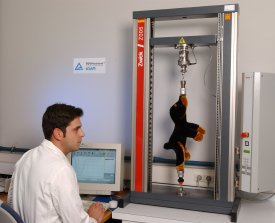Jul 25 2008
A toy is defined in law as a product intended for children under 14 to play with. Every year thousands of new toys enter the market and as parents we don’t expect them to harm our children, but how can we be sure?

Since January 1, 1990, toys can only be placed in the European market if they bear the CE Mark. Toy manufacturers are therefore under a legal obligation to ensure that their products are thoroughly tested, and they and their dealers have special tests performed by organisations such as LGA in Nuremberg, Germany. After successful results the LGA can also award the GS (geprüfte Sicherheit = certified safety) mark.
Using a Zwick Z005 testing machine equipped with a 500N load cell, LGA carries out many mechanical tests which enable everyday situations which might arise in the playground or home to be simulated in the laboratory under controlled conditions.
One example is when a child tugs at a stuffed dog’s muzzle with its teeth. The muzzle must remain fully attached even when a tensile load of 90N (9kg / 20lbs) is applied using the Zwick machine. With other toys it is absolutely vital that no small parts can become detached, as swallowing them can be fatal for children. Subjecting parts of the toy to such pulling, pushing, tearing, bending, and cycling forces is child’s play using latest Zwick’s testXpert® II software because all the important parameters of the test machine such as crosshead speed, travel distances, required force limits, and loading profiles can be setup and stored in the software.
Accuracy and consistency are so important and LGA benefits from the wide range of applications which are possible from a single load cell. For example, the 500N (112 lb) load cell achieves ISO 7500 Class 1 down to a lower limit of 1N (0.22 lbs). This means that forces measured at 1N have an accuracy of 0.01N (0.0022 lbs). This saves the time and cost of purchasing and setting up secondary load cells.
In addition to mechanical and physical tests on toys LGA also performs chemical tests and checks for flammability, conformity with LFGB (food safety legislation), electrical safety, electromagnetic compatibility (EMC), radio frequency authorisation and hygiene.
The flexibility of the Zwick machine means that it can be equipped with various sensors, tools and fixtures. Control and evaluation of the tests is performed automatically by the testXpert II software. The operator can quickly perform widely differing tests due to the intelligent wizards and context sensitive system.
The measured values and results are shown on the screen during the test, and all test results can be directly processed, printed out, forwarded, exported and archived.
For more information on toys, click here.